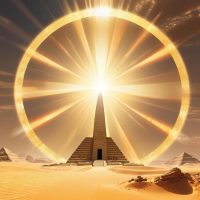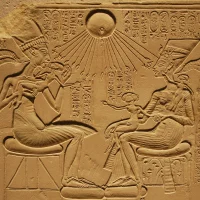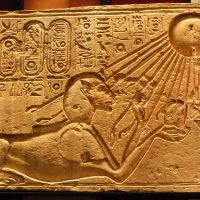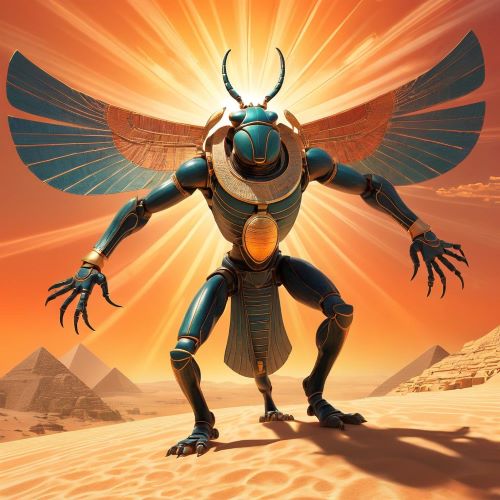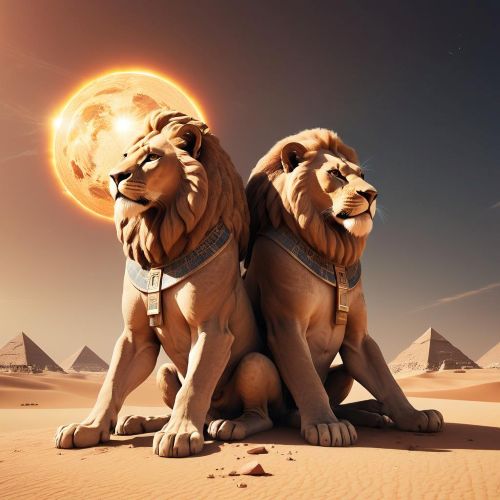Aten : The Sun Disc
Listen
At a glance
| Description | |
|---|---|
| Origin | Egyptian Mythology |
| Classification | Gods |
| Family Members | N/A |
| Region | Egypt |
| Associated With | Sun, Royalty |
Aten
Introduction
Aten, often referred to as the solar disk, holds a distinguished place in ancient Egyptian religion and history. Unlike the anthropomorphic gods of Egypt’s vast pantheon, Aten symbolized the visible sun itself—the radiant orb that sustained life across the world. His worship rose to prominence during the reign of Pharaoh Akhenaten (formerly Amenhotep IV), who reigned between 1353 and 1336 BCE. Akhenaten’s devotion to Aten brought forth a revolutionary shift from the traditional polytheism of Egypt to what is widely regarded as one of the first instances of monotheism in human history. This period, known as the Amarna Revolution, centered Aten as the sole source of divine energy and existence, emphasizing a direct, personal connection between the pharaoh and the god.
Physical Traits
Aten’s representation departed dramatically from the conventional imagery of Egyptian deities. Instead of being depicted with human or animal features, Aten appeared as a circular sun disc with rays stretching downward, each ray ending in a tiny hand. These hands often held ankhs—the Egyptian symbols of life—signifying Aten’s power to bestow vitality upon the Earth and its inhabitants. This visual design communicated Aten’s role as the life-giving force behind all creation. Because Aten embodied the visible and intangible aspects of sunlight, he was never enclosed within temples but rather worshipped in open courtyards that allowed the sun’s rays to touch the altar directly. This distinctive architectural feature reinforced Aten’s identity as the source of light, warmth, and universal sustenance.
Family
In contrast to other gods who possessed intricate genealogies, Aten did not have a divine family of his own. Instead, his spiritual family was represented through the royal household, particularly Pharaoh Akhenaten, Queen Nefertiti, and their six daughters. The pharaoh declared himself the “son of Aten” and Nefertiti as the “beloved of Aten,” creating a divine trinity that unified god, king, and queen in sacred purpose. Royal women were given unprecedented prominence during this era, often shown alongside the pharaoh beneath Aten’s rays, participating in religious rituals that were once restricted to male priests. The royal family thus became both the embodiment and the mediators of Aten’s will, symbolizing the direct flow of divine energy from the sun to the ruler and his people. This reconfiguration of divine representation also diminished the influence of Egypt’s powerful priesthood, consolidating spiritual authority within the monarchy.
Other names
The name “Aten,” translated as “the sun disk,” was not new to Egyptian religion but originally referred to a visible aspect of the sun associated with Ra, the great solar deity. During the Amarna Period, Akhenaten elevated Aten to supreme status, separating him from Ra and defining him as a distinct, singular god. Aten was often referred to in royal inscriptions with elaborate titles, such as “Ra-Horus who rejoices in the horizon in his name of the light which is seen in the sun disk.” Over time, this title was shortened simply to “Aten,” reflecting his transformation from an aspect of Ra to an independent divine force. The deity’s name was frequently enclosed in double cartouches, a distinction previously reserved for royal names, indicating Aten’s elevated position as the singular, universal god. The capital city Akhetaten—modern-day Amarna—was named in his honor, meaning “Horizon of the Aten.”
Powers and Abilities
Aten’s powers embodied the fundamental principles of creation, life, and cosmic balance. He was not a god of specific domains like fertility or war but rather the universal source of existence itself. The Great Hymn to the Aten, one of the most remarkable surviving religious texts from the period, celebrates Aten as the creator of all things, from the Nile that nourished Egypt to the rain that sustained lands beyond its borders. Aten’s light was said to awaken life each morning, causing plants to bloom, animals to rise, and humans to go about their daily labor. When Aten set, darkness returned, and the world rested. His omnipresence transcended Egypt’s borders, highlighting a rare universalism that recognized all races and nations as part of a shared divine creation.
Aten’s role as the sustainer of life also made him a moral and spiritual symbol of order and truth. His light illuminated the righteous path, while his absence represented chaos and ignorance. Unlike other Egyptian gods who required intermediaries in vast temple hierarchies, Aten’s connection was direct but exclusive—channeled solely through the pharaoh, who alone understood his divine will. This centralization of divine authority emphasized Akhenaten’s spiritual and political power, blending theology with governance.
Modern Day Influence
Although Atenism was short-lived, ending soon after Akhenaten’s death, its philosophical and theological impact has echoed through centuries of religious study. The experiment in monotheism foreshadowed the later emergence of single-deity faiths such as Judaism, Christianity, and Islam, though direct connections remain speculative. Scholars have long noted the striking similarities between the Great Hymn to the Aten and Psalm 104 of the Hebrew Bible, both celebrating a single deity as the creator and sustainer of life. Egyptologist Jan Assmann has argued that Akhenaten’s concept of divine unity may have influenced early monotheistic thought through cultural exchange, though others, such as Miriam Lichtheim, attribute these parallels to shared literary traditions rather than direct borrowing.
Atenism also left an indelible mark on art and culture. The Amarna period introduced a revolutionary artistic style that broke away from rigid conventions, favoring naturalistic depictions of the royal family basking in Aten’s rays. This art reflected a deeper philosophical shift toward depicting divine intimacy and familial affection, qualities seldom emphasized in earlier Egyptian iconography.
In modern scholarship and popular culture, Aten and Akhenaten continue to inspire fascination as symbols of religious reform, visionary leadership, and the human quest for divine understanding. The ruins of Amarna remain a vital archaeological site, providing insight into a civilization that briefly reimagined its relationship with the divine. Contemporary artists, historians, and theologians often revisit Atenism to explore themes of light, truth, and monotheism’s origins. Composer Philip Glass immortalized the story in his 1984 opera Akhnaten, blending ancient hymns and modern minimalism to capture the spiritual intensity of this forgotten god.
Though Aten’s cult was dismantled and erased from monuments by Akhenaten’s successors, his brief reign as Egypt’s sole god remains a powerful testament to humanity’s enduring desire to comprehend the divine in the unity of light and life. Aten’s worship may have flickered out in antiquity, but the questions it raised—about faith, power, and the nature of creation—continue to shine through history, as enduring as the sun itself.
Related Images
Source
Egyptian History. (2021, January 7). Aten, the Solar Disc god. Egyptian-History.com. https://egyptian-history.com/blogs/egyptian-gods/god-aton
Braverman, I. M., Redford, D. B., & Mackowiak, P. A. (2009). Akhenaten and the strange physiques of Egypt’s 18th dynasty. Annals of Internal Medicine, 150(8), 556-560. https://pubmed.ncbi.nlm.nih.gov/19380856/
Mythology: Gods and Monsters. (2024, December 1). Myth of the Day: Aten. Substack. https://godsandmonstersinfo.substack.com/p/myth-of-the-day-aten
Britannica. (2025, January 23). Aton | Sun God, Creator Deity, Solar Disc. Britannica.com. https://www.britannica.com/topic/Aton
Wikipedia contributors. (2002). Aten. Wikipedia. https://en.wikipedia.org/wiki/Aten
Fiveable. (2024, July 21). 13.1 The Rise of Atenism and Monotheism. Fiveable.me. https://fiveable.me/gods-graves-and-pyramids-ancient-egyptian-religion-and-ritual/unit-13/rise-atenism-monotheism/study-guide/HGyqa1rQPjOVqVoB
Ancient Egypt Time Travel. (2025, July 31). Top 34 Ancient Egyptian Gods and Goddesses. EgyptTimeTravel.com. https://egypttimetravel.com/ancient-egyptian-gods-and-goddesses/
AEON. (2020, August 2). Why did an ancient Egyptian king erase all gods but Aten? Aeon.co. https://aeon.co/essays/why-did-an-ancient-egyptian-king-erase-all-gods-but-aten
Hornung, E. (1999). Akhenaten and the Religion of Light. Cornell University Press.
Assmann, J. (2001). The Search for God in Ancient Egypt. Cornell University Press.
Redford, D. B. (1984). Akhenaten: The Heretic King. Princeton University Press.
Wilkinson, R. H. (2003). The Complete Gods and Goddesses of Ancient Egypt. Thames & Hudson.
Kemp, B. J. (2012). The City of Akhenaten and Nefertiti: Amarna and Its People. Thames & Hudson.
Frequently Asked Questions
What is lorem Ipsum?
I am text block. Click edit button to change this text. Lorem ipsum dolor sit amet, consectetur adipiscing elit. Ut elit tellus, luctus nec ullamcorper mattis, pulvinar dapibus leo.
What is lorem Ipsum?
I am text block. Click edit button to change this text. Lorem ipsum dolor sit amet, consectetur adipiscing elit. Ut elit tellus, luctus nec ullamcorper mattis, pulvinar dapibus leo.
What is lorem Ipsum?
I am text block. Click edit button to change this text. Lorem ipsum dolor sit amet, consectetur adipiscing elit. Ut elit tellus, luctus nec ullamcorper mattis, pulvinar dapibus leo.
What is lorem Ipsum?
I am text block. Click edit button to change this text. Lorem ipsum dolor sit amet, consectetur adipiscing elit. Ut elit tellus, luctus nec ullamcorper mattis, pulvinar dapibus leo.
What is lorem Ipsum?
I am text block. Click edit button to change this text. Lorem ipsum dolor sit amet, consectetur adipiscing elit. Ut elit tellus, luctus nec ullamcorper mattis, pulvinar dapibus leo.


